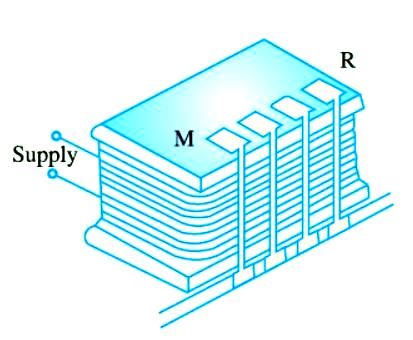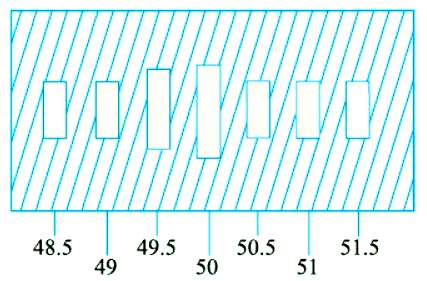The Vibrating-reed Frequency Meter
Working Principle – The Vibrating-reed Frequency Meter:
The Vibrating-reed Frequency meter depends for its indication on the mechanical resonance of thin flat steel reeds arranged alongside and, close to, an electromagnet as shown in Fig. 10.68.


Construction of Vibrating-reed Frequency Meter
The electromagnet has a laminated armature and its winding, in series with a resistance, is connected across a.c. supply whose frequency is required. In that respect, the external connection of this meter is the same as that of a voltmeter. The metallic reeds (about 4 mm wide and 0.5 mm thick) are arranged in a row and are mounted side by side on a common and slightly flexible base which also carries the armature of the electromagnet. The upper free ends of the reeds are bent over a right angles so as to serves as flags or targets and enameled white for better visibility. The successive reeds are not exactly similar, their natural frequencies of vibration differing by 1/2 cycle. The reeds are arranged in ascending order of natural frequency.
AdBlock-2

Working of Vibrating-reed Frequency Meter
When the electromagnet is connected across the supply whose frequency is to be measured, its magnetism alternates with the same frequency. Hence the electromagnet exerts attracting force on each reed once every half cycle. All reeds tend to vibrate but only that whose natural frequency is exactly double the supply frequency vibrates with maximum amplitude due to mechanical resonance [Figure C].
The supply frequency is read directly by noting the scale mark opposite the white painted flag which is vibrating the most (f = 50 Hz). The vibrations of other reeds would be so small as to be almost unobservable. For a frequency exactly midway between the natural frequencies of the two reeds (f = 49.75 Hz), both will vibrate with amplitudes which are equal but much less than when the supply frequency exactly coincides with that of the reeds.

Range of Vibrating-reed Frequency Meter
Such meters have a small range usually from 47 to 53 Hz or from 57 to 63 Hz etc. The frequency range of a given set of reeds may be doubled by polarising the electromagnets as explained below. As seen from above description, each reeds is attracted twice per cycle of the supply i.e., once every half-cycle and the reeds whose natural frequency is twice that of the current is of the one which responds most. Suppose the electromagnet carries an additional winding carrying direct current whose steady flux is equal in magnitude to the alternating flux of the a.c. winding. The resultant flux would be zero in one half-cycle and double in the other half-cycle when the two fluxes reinforce each other so that the reeds would receive one impulse per cycle. Obviously, a reed will indicate the frequency of the supply if the electromagnet is polarised and half the supply frequency if it is unpolarised. The polarisation may be achieved by using an extra d.c. winding on the electromagnet or by using a permanent tangent which is then wound with an a.c. winding.
Advantages & Disadvantages :
One great advantage of this reed-type meter is that its indications are independent of the waveform of the applied voltage and of the magnitude of the voltage, except that the voltage should be high enough to provide sufficient amplitude for reed vibration so as to make its readings reliable.
However, its limitations are :
(a) it cannot read closer than half the frequency difference between adjacent reeds.
(b) its error is dependent upon the accuracy with which reeds can be turned to a given frequency.
Read article – Units of Resistivity
Visit NCERTplanet.com for NCERT solutions and Textbook downloads




